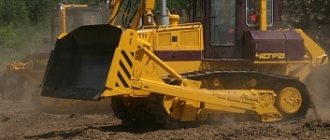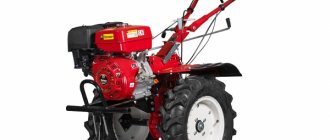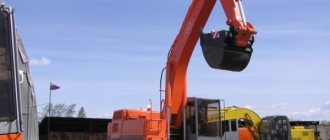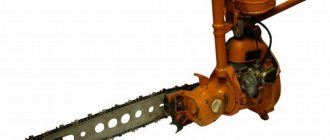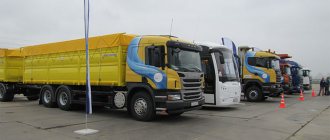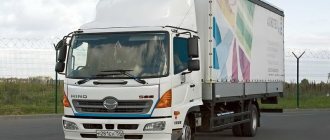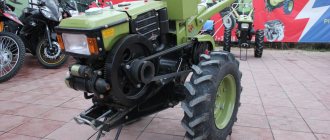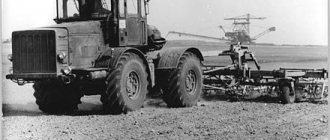| Chelyabinsk Tractor Plant | |
| S-65 tractors at the workshops, 1930s. | |
| Type | Limited liability company[d] |
| Base | 1933 |
| Location | Russia Russia: Chelyabinsk |
| Industry | Mechanical engineering |
| Products | Tractors, engines, spare parts |
| Number of employees | 7.6 thousand people |
| Parent company | Uralvagonzavod |
| Website | chtz-uraltrac.ru |
| Chelyabinsk Tractor Plant on Wikimedia Commons | |
| Awards |
Chelyabinsk Tractor Plant
(until October 6, 1941 -
Chelyabinsk Tractor Plant named after I.V. Stalin
, until June 20, 1958 -
Kirov Plant of the People's Commissariat of Tankoprom in Chelyabinsk
, from November 10, 1971 to October 1, 1992 -
production association "Chelyabinsk Tractor Plant" Plant named after V.I. Lenin
) is a machine-building enterprise for the development and production of wheeled and tracked road construction equipment (bulldozers, pipe layers, front-end loaders, mini tractors), internal combustion engines, spare parts and other high-tech engineering products. It was popularly known under the common name “Tankograd”[1][2].
The number of employees is more than 7,600 people. The production area occupied by the enterprise is 1.2 million m2.
The operator (owner) of the enterprise is Chelyabinsk Tractor Plant - Uraltrak LLC.
History of ChTZ
Before the war
S-65 in the VAZ equipment museum (Tolyatti)

The construction of a tractor plant in Chelyabinsk was provided for by the first five-year plan for 1928-1932 adopted by the Fifth Congress of Soviets of the USSR. On May 29, 1929, the Council of People's Commissars adopted a resolution on the construction of a tractor plant in the Urals. The production capacity of the plant was planned at 40 thousand tractors per year. The American Caterpillar 60 tractor was chosen as the prototype of the first tractor. The construction of the plant was carried out with the involvement of specialists from the USA and other countries. The design of the plant was carried out by an architectural team from Detroit (USA)[3], which had previously designed the Stalingrad Tractor Plant (and before that, before the Great Depression of 1929-1933 - the Ford factories and other US automobile factories) by the famous American architect Albert Kahn (1869-1942) [4]. On the Soviet side, the design was led by architects A. S. Fisenko, V. Shvetsov and A. Velichkin[5][6]. Construction was carried out by the Traktorostroy trust, created in 1929[7]. The head of the trust, K.P. Lovin, organized the Chelyabinsk Tractorplant design bureau in Detroit in March 1930, and by June 1, 1930, a master plan for the plant was developed based on the preliminary design of the Leningrad Design Institute "GIPROMEZ"[8][9]. The bureau consisted of 40 specialists from the USSR and 12 from the USA. At the end of 1930, construction was under threat due to various kinds of difficulties that arose, in connection with which a resolution of the Central Committee of the All-Union Communist Party of Bolsheviks was adopted “On the progress of construction of the Chelyabinsk Tractor Plant,” control over the implementation of which was entrusted to N. M. Shvernik [10 ].
On May 15, 1933, the first tracked tractor “Stalinets-60” (S-60) came out of the assembly shop gates. However, the official opening of the plant took place on June 1. The S-60 tractors were equipped with 4-stroke, 4-cylinder carburetor engines with a power of 72 hp, running on naphtha fuel and, weighing 9.5 tons, had a maximum tractive effort of 4.45 tons.
1936 The company’s tractors take part in two grandiose expeditions: the “Snow March” - covering two thousand kilometers across Yakutia at a temperature of minus 50 degrees, and the Pamir crossing at an altitude of 4 thousand meters in the Turkestan Military District.
May 1937. At the World Exhibition in Paris, the S-65 tractor was awarded the highest award - the Grand Prix diploma.
On June 20, 1937, serial production of the Stalinets-65 (S-65) tractor with a capacity of 65 horsepower and a diesel engine began. ChTZ was the first in the country to master the production of fuel equipment for diesel engines. ChTZ became a pioneer in the Soviet tractor diesel industry.
1939 ChTZ has mastered the production of military equipment - the artillery tractor "Stalinets-2" (S-2) with a capacity of 105 horsepower.
1940 Tractor builders carried out experimental work on mastering the production of heavy KV tanks designed by the Leningrad Kirov plant, and the 12-piston fuel pump “TN-12” for aircraft engines of heavy bombers. On December 31, 1940, the state commission accepted the first Chelyabinsk tank.
March 30, 1940. The 100,000th tractor rolled off the assembly line. The total power of Chelyabinsk tractors produced was 6 million horsepower, or ten Dneproges.
The plant during the Great Patriotic War
After the start of the Great Patriotic War, the plant continued to produce tractors, artillery tractors and KV-1 heavy tanks[11].
In October 1941, ChTZ, together with seven enterprises partially and completely evacuated to Chelyabinsk, formed a tank-building plant, later unofficially called “Tankograd”
.
In particular, the Kharkov Motor Plant No. 75 and the Leningrad Kirov Plant were completely evacuated here, and therefore on October 6, 1941, the plant was renamed the “Kirov Plant of the People’s Commissariat of Tank Industry in the city of Chelyabinsk”
[12][13] (plant No. 100) . In August 1942, production of T-34 tanks began, in February 1943 - self-propelled artillery mounts, in September 1943 - heavy tanks [11]. In a short time, the plant became one of the main arsenals of the front; during the war years it produced: 18 thousand tanks and self-propelled guns; 48.5 thousand tank diesel engines; 17.7 million ammunition stockpiles.
The enterprise created 13 types of new tanks and self-propelled guns, 6 types of tank diesel engines, in particular the B-2 modification. For the first time in world tank building practice, the assembly of heavy tanks was put on an assembly line.
During the war, the plant was awarded the Red Banners of the State Defense Committee for victory in the All-Union competition 33 times. Two banners were left to the team for eternal storage.
After the war
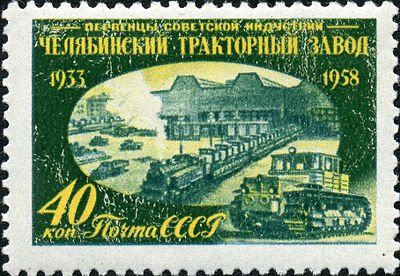
On January 5, 1946, the first Stalinets-80 tractor was assembled. In 1956, the Stalinets-100 tractor was created.
On June 20, 1958, the plant was renamed the Chelyabinsk Tractor Plant.
In January 1961, a tractor with an electromechanical transmission, DET-250, was put into serial production.
On October 9, 1963, the first production tractor T-100M with a capacity of 108 horsepower rolled off the main assembly line. To increase labor productivity, increase the reliability and durability of tractors when working in various climatic conditions (swamps, sand, permafrost, etc.), modifications of the basic model were developed and introduced into mass production. So in 1964, ChTZ produced 22 versions of the T-100M tractor. This tractor, including all its modifications, became the most popular in the history of the enterprise: a total of 412,145 copies were produced.
At the end of the 60s, in the context of the existing production of industrial tractors T-100M, its radical reconstruction and technical re-equipment began to begin production of T-130 tractors. On May 26, 1970, the construction and reconstruction of ChTZ were declared an All-Union Komsomol shock construction project.
On November 10, 1971, the first production association in the tractor and agricultural engineering industry of the USSR, the Chelyabinsk Tractor Plant named after V. I. Lenin, was created.
On August 6, 1982, on the northern slope of Elbrus at a two-kilometer altitude, where the high-mountain front of the Great Patriotic War took place, an obelisk was installed at the base of which are parts of the mutilated S-60 tractor, which was used as a military tractor.
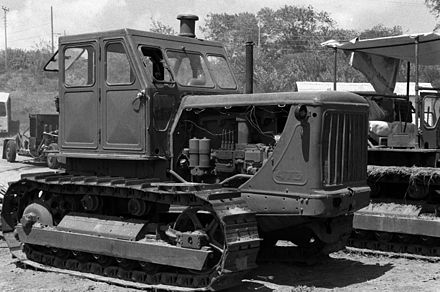
Tractor T-100
On June 1, 1983, for the golden anniversary of ChTZ, the first tractor S-60, the first Soviet tracked vehicle, was installed on a pedestal on the pre-factory square, and the world's first heavy-duty energy-rich domestic tractor T-800 with an 820 horsepower engine, intended for development, was assembled especially heavy frozen and rock formations without explosion.
On November 3, 1984, the plant produced the millionth tractor with the ChTZ brand (T-130M)[14].
March 1988 - tractor manufacturers began production of the T-170 tractor, equipped with a modernized diesel engine. This year, the plant reached maximum productivity in the production of tractors: 31.5 thousand machines rolled off the assembly lines.
January 1989 - serial production of the DET-250M2 tractor began.
September 1990 - the T-800 bulldozer-ripper is listed in the Guinness Book of Records as the largest and most productive in the world[15].
December 30, 1990 - the first production tractor T10 with a hydromechanical transmission was released.
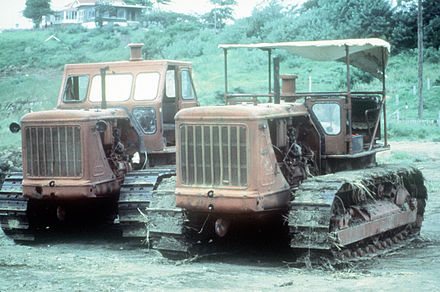
ChTZ tractors - T-100 and T-108
Plant after 1991
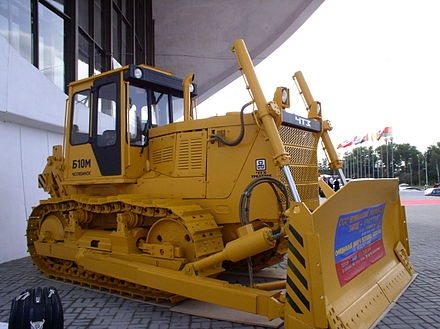
April 30, 1992 - Order of the Government of the Russian Federation N 835-r “On the privatization of the production association “Chelyabinsk Tractor Plant named after V. I. Lenin”
October 1, 1992 - Production Association “Chelyabinsk Tractor Plant named after. V.I. Lenin" was transformed into the joint-stock company "URALTRAK" (JSC "URALTRAK") on the basis of a general meeting of shareholders.
April 27, 1996 - The Uraltrak joint-stock company was renamed into the Chelyabinsk Tractor Plant open joint-stock company on the basis of a general meeting of shareholders.
1998 - bankruptcy, reorganization, emergence of a new enterprise: ChTZ-Uraltrak LLC
November 1999 - serial production of the V-92 C2 tank diesel engine was mastered.
On September 25, 2000, at the international exhibition “URALSTROY - 2000” (Ufa), ChTZ products were awarded the first degree Gold Cup.
June 1, 2002 - serial production of the T10 tractor.
July 20, 2002 - a prototype of the T3 tractor of modular design was manufactured.
July 25, 2002 - the first regional shopping center was opened in Perm.
October 2002 - a prototype of the DET-320 tractor with an engine from the Yaroslavl Motor Plant was assembled.
December 18, 2002 - a quality certificate (Sample Test Certificate) was received for the B-10.02 bulldozer at the UES Certification Center (Germany).
July 1, 2003 - serial production of the T10M tractor and units based on it was launched.
In 2008, it produced products worth 12.364 billion rubles. (16.2% more than in 2007), releasing:
- 162 pipelayers,
- 1,944 bulldozer-ripper equipment,
- 71 heavy tractors DET-250 and DET-320,
- spare parts - in the amount of 2 billion 853.766 million rubles. (an increase of 28.7%).
The volume of product exports in 2008 amounted to 1,916.4 billion rubles. (an increase of 0.2%). Export of spare parts - 417.83 million rubles. (an increase of 5.9%)[16].
ChTZ as part of Uralvagonzavod
In March 2011, the Uralvagonzavod Research and Production Corporation acquired a 63.3% stake in ChTZ. Taking into account previously existing shares, Uralvagonzavod now owns 80% of ChTZ shares. The rest are held by the government of the Chelyabinsk region, which is negotiating with UVZ on the transfer of these shares.
The deal between Uralvagonzavod and ChTZ won the “Deal of the Year” category at the annual interregional award “Results of the Year of the Urals and Siberia-2011”[17].
As part of UVZ, the Chelyabinsk Tractor Plant should become one of the main enterprises for the production of civil equipment, in particular, road construction equipment. A heavy engineering division will be built on the basis of ChTZ[18].
In 2011, ChTZ completed a number of export contracts. Exports were carried out to almost all republics of the former USSR, as well as to Vietnam. In January-August alone, exports increased in volume terms by 36%[19].
The largest export contract was the supply of 100 B-10M bulldozers to the Ministry of Water Resources and Land Reclamation of Turkmenistan, intended for clearing the beds of irrigation canals in the Kara-Kum desert.
In Russia, ChTZ completed a large contract for the supply of 300 units of specialized engineering equipment to equip regional fire-chemical stations of Rosleskhoz; Machines were supplied to a number of oil and gas corporations.
The presence of a large number of contracts allowed ChTZ to resume hiring workers for the first time in recent years[20].
ChTZ today
Today[ clear
] ChTZ offers the consumer:
- tractors T10M, DET-250M2 and engineering vehicles based on them;
- pipelayers with a lifting capacity of 12.5 and 20 tons;
- bulldozers B10M;
- vibratory rollers, loaders and bulldozers based on wheeled modules weighing 24 tons;
- diesel engines with power from 12 to 1200 horsepower;
- diesel generator sets with a capacity of 100 kW for autonomous power supply;
- diesel-hydraulic stations for installations for collecting oil products from water surfaces;
- spare parts for ChTZ tractors;
- consumer goods, including: universal wheeled-caterpillar mini-tractor “Uralets” (12 hp);
- municipal vehicle T-02.03.2 and other goods.
Curious facts
ChTZ has manufactured more than 1,268,000 tractors over its 80 years of operation. They moved about 350 cubic kilometers of soil. They could cover the entire surface of the Moon with a layer of three and a half centimeters. And to transport the soil removed by ChTZ equipment would require a train 135.5 million kilometers long. The ChTZ machines themselves covered about 90 billion kilometers on the planet—that is, 600 distances from the Earth to the Sun[21].
Bulldozer T-800 ChTZ
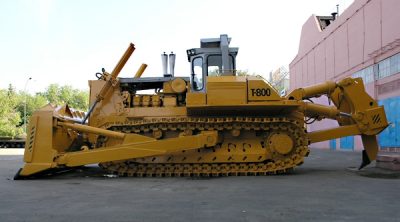
T-800 is a super-heavy tracked tractor operating as part of a bulldozer-ripper unit. This model is a product of the Chelyabinsk Tractor Plant. T-800, also known as T-75.01, is considered the largest tractor produced in Europe. The model is listed in the Guinness Book of Records, where it was called the most productive in the world. The T-800 belongs to the 75 traction class and is equipped with ripping and bulldozer equipment.
The first copy of the T-75.01 rolled off the assembly line back in 1983. The equipment is intended for performing huge volumes of earthworks in land reclamation and road construction and stripping operations with increased energy intensity in the mining industry. The T-800 is also actively used for the development of rocky and frozen soils (open-pit mining) in various climatic conditions.
The appearance of such a “colossus” was due to several factors. A significant increase in production standards in mining and construction required more powerful tractors. Conventional bulldozers could no longer cope with the assigned tasks. That is why specialists from the Chelyabinsk plant began to develop heavy and high-performance equipment capable of meeting increased needs.
Specifications
ChTZ T-800 is the largest tractor currently produced.
- Dimensions of the equipment: height – 4775 mm, width – 4185 mm, length – 7945 mm.
- The model has a wheelbase of 6220 mm and a track of 2880 mm.
- The working weight of the T-800 with bulldozer and loosening equipment is 106 tons.
- At the same time, 29.5 tons account for equipment.
- The tractor uses 2 types of tracks: for loam weighing 8 tons and for rocky soil weighing 6 tons. This allows you to reduce the pressure on the ground to 0.0914 (0.932) MPa (kgf/sq.cm).
- The product of the Chelyabinsk Tractor Plant is equipped with an 820-horsepower unit.
- The specific fuel consumption of the equipment is 230 g/kW per hour.
- With such consumption, the model requires a spacious fuel tank, which is why the T-800 is equipped with a 2050-liter fuel tank. The maximum traction force of the bulldozer is 140 tons, the nominal force is 75 tons.
Awards
- Order of Lenin (1971),
- Order of the Red Banner of Labor (1983),
- Order of Kutuzov, 1st degree (1945),
- Order of the Red Star (1944).
- The Order of Lenin was awarded to the pilot plant (1944) and the diesel design bureau (1945).
- 12 tractor builders were awarded the title of Hero of Socialist Labor.
- August 25, 2003 - ChTZ - Uraltrak LLC was awarded the Order of Friendship of the State of Vietnam[22].
- In December 2010, ChTZ products—the T-13 medium tracked tractor and the PK-65 heavy wheeled front loader—won the All-Russian competition “100 Best Products of Russia”[23].
- In 2011, ChTZ’s new product, the B8 bulldozer, received several awards. It was among the twenty best goods of the Chelyabinsk region, and in November became a laureate of the “100 Best Goods of Russia” competition[24].
- In 2011, ChTZ products were included in the top hundred best products of the Southern Urals, and the Ministry of Economic Development awarded the category “Tractors and vehicles for industrial use” in the industry.
Directors
- Lovin Kazimir Petrovich (?) - beginning. Traktorostroya
- Safrazyan Leon Bogdanovich (?) - beginning. Traktorostroya
- Ilyichev Vasily Ivanovich (April 1931 - September 1932)
- Lovin Kazimir Petrovich (1932-1934)
- Bruskin Alexander Davidovich (1934-1936)
- Nesterovsky Israel Yakovlevich (1936 - July 1938)
- Solomonovich I.D. (-1940-)
- Zaltsman Isaac Moiseevich (October 1941 - February 1942)
- Makhonin Sergei Nestorovich (February - November 1942)
- Goreglyad Alexey Adamovich (November 1942 - February 1943)
- Dlugach Moisey Abramovich (February - June 1943)
- Zaltsman Isaac Moiseevich (June 1943 - July 1949)
- Skachkov Semyon Andreevich (July 1949 - April 1954)
- Kritsyn Alexander Ilyich (1954-1961)
- Zaichenko Georgy Vasilievich (1961-1979)
- Lozhchenko Nikolay Rodionovich (1979-1995)
- Pozdeev Valery Semyonovich (November - December 1995)
- Kichedzhi Vasily Nikolaevich (December 1995 - February 1998)
- Platonov Valery Mikhailovich (February 1998 - August 2011)
- Mlodik Semyon Gennadievich (August 2011 - October 2012)
- And. O. Golygin Sergey Alexandrovich (October 2012 - November 2013)
- Voropaev Viktor Viktorovich (November 2013 - June 2015)
- Mikhel Evgeniy Valerievich (June 2020 - June 2016)
- And. O. Yumatov Vyacheslav Gennadievich (since June 2020)
Notes
- “Tankograd” // Great Patriotic War 1941-1945: encyclopedia / Ch. ed. M. M. Kozlov. - 1985. - P. 707. - 832 p. — 500,000 copies.
- Chelyabinsk Tractor Plant // Great Patriotic War 1941-1945: encyclopedia / Ch. ed. M. M. Kozlov. - 1985. - P. 779. - 832 p. — 500,000 copies.
- Meerovich M. G. Albert Kahn in the history of Soviet industrialization. Archived January 30, 2010.
- Journal "Expert" No. 1 (687) / December 28, 2009. Maxim Rubchenko (editor of the economics department). Hooray, they are depressed!
- Meerovich M. G.
Architect in Soviet history. Anatoly Fisenko and Albert Kahn // Project-Baikal. - 2009. - No. 20. - P. 156-161. - S. Demidov, A. Khrustalev.
Anatoly Stepanovich Fisenko // Architecture of the USSR. - 1982. - No. 9. - P. 51. - Fista T.V. Chelyabtractorostroy
- article in the electronic version of the encyclopedia "Chelyabinsk" (Chelyabinsk: Encyclopedia / Compiled by: V.S. Bozhe, V.A. Chernozemtsev. - Ed. correction and additional - Chelyabinsk: Stone Belt, 2001 . - 1112 pp.; ill. ISBN 5-88771-026-8). - Shmakova. N. P. Chelyabinsk tractor plant
- article in the electronic version of the encyclopedia "Chelyabinsk" (Chelyabinsk: Encyclopedia / Compiled by: V. S. Bozhe, V. A. Chernozemtsev. - Ed. correction and additional. - Chelyabinsk: Stone Belt, 2001. - 1112 pp.; ill. ISBN 5-88771-026-8). - Shmakova. N. P. Lovin Kazimir Petrovich
- article in the electronic version of the encyclopedia "Chelyabinsk" (Chelyabinsk: Encyclopedia / Compiled by: V. S. Bozhe, V. A. Chernozemtsev. - Ed. corrected and supplemented. - Chelyabinsk: Stone Belt, 2001. - 1112 pp.; ill. ISBN 5-88771-026-8). - Shmakova N.P. On the progress of construction of the Chelyabinsk Tractor Plant
- an article in the electronic version of the encyclopedia "Chelyabinsk" (Chelyabinsk: Encyclopedia / Compiled by: V.S. Bozhe, V.A. Chernozemtsev. - Edited and supplemented - Chelyabinsk : Stone Belt, 2001. - 1112 pp.; ill. ISBN 5-88771-026-8). - ↑ 12
Chelyabinsk Tractor Plant // Military encyclopedic dictionary / In 2 volumes. Volume 2. - Editorial team: A. P. Gorkin, V. A. Zolotarev, V. M. Karev, etc. - M.: Great Russian Encyclopedia, “RIPPOL CLASSIC”, 2001, 816 p. P. 741. ISBN 5-7905-0996-7 - [1], Archived copy (inaccessible link - history
). Retrieved March 4, 2011. Archived November 11, 2014. Kirov Plant of the People's Commissariat of Tank Industry - Komarov L. S. Chronicle of the Chelyabinsk tractor / L. S. Komarov, E. G. Khoviv, N. I. Zarzhevsky. - M., 1972
- Eroshkin A. S. The millionth ChTZ tractor
- article in the electronic version of the encyclopedia "Chelyabinsk" (Chelyabinsk: Encyclopedia / Compiled by: V. S. Bozhe, V. A. Chernozemtsev. - Ed. correction and additional. - Chelyabinsk: Stone Belt , 2001. - 1112 pp.; ill. ISBN 5-88771-026-8). - The second life of a record holder - Chelyabinsk Tractor Plant (ChTZ)
- At the end of 2008, ChTZ-Uraltrak increased the production of special equipment by 16.2%
- "ITAR-TASS Ural" - "UVZ" won in 2 categories of the award "Results of the Year of the Urals and Siberia-2011" Archived on June 25, 2020.
- “The day before. Ru" - Semyon Mlodik - about ChTZ: We need to develop step by step. And no assault
- LLC "ChTZ-Uraltrak" in January-August 2011 increased the export of equipment in physical terms by 36%
- ChTZ resumed hiring workers
- New ChTZ calendar: entertaining arithmetic: “Ural-press-inform”, 02/07/2011
- History – Chelyabinsk Tractor Plant (ChTZ)
- ChTZ bulldozers are among the hundred best products in Russia
- "ITAR-TASS Ural" - The mini-bulldozer B-8 of the Chelyabinsk Tractor Plant won the competition "100 Best Products of Russia"
Lecture 14 Chelyabinsk Tractor Plant
History of ChTZ development
The fate of the Chelyabinsk Tractor Plant is inextricably linked with the history of the country. Built in record time and becoming a symbol of the labor enthusiasm of the first five-year plans, ChTZ in the 30s of the 20th century had no analogues either in Europe or in America.
During the Great Patriotic War, the labor valor of the Tankograd workers ensured the technical superiority of our tanks over enemy combat vehicles. Without Chelyabinsk tractors it is impossible to imagine the post-war reconstruction of the country.
Ural heroes worked on all major construction sites. Powerful machines with the ChTZ emblem can be found on all continents - from the deserts of Africa to the endless snows of Antarctica, and everywhere they serve with honor.
Largest in the world
The 30s of the 20th century will remain in the history of our country as a time of unprecedented industrial development. The creation of a domestic tractor industry, of which ChTZ became the flagship, was of great importance for the state.
On May 29, 1929, the Council of People's Commissars of the USSR adopted a resolution “On starting the construction of a tractor plant in the Urals.” It was no coincidence that Chelyabinsk was chosen as the location for its construction: the coal mines of Kopeisk could provide the future giant plant with cheap fuel, the ChGRES with the necessary energy, and the Magnitogorsk Iron and Steel Works, which was being built at an unprecedented pace, with cast iron and coke.
The city's location on the Trans-Siberian Railway made it possible to significantly reduce transport costs when delivering tractors to the eastern regions of the country.
In November 1929, an order of the Supreme Economic Council of the USSR approved: the future enterprise should become the country's first plant for large-scale production of tracked tractors and produce 40 thousand vehicles per year. That is, one and a half times more than the Stalingrad and Kharkov factories under construction combined.
Master plan from Detroit
Already by the spring of 1930, a preliminary design of the enterprise was completed in a design bureau specially organized in Leningrad. The country's leadership understood that the construction of such a giant was possible only by using all the advanced experience accumulated by that time in the global tractor industry.
It was not possible to agree on technical assistance with the American company Caterpillar: the demands put forward were unacceptable. Then Soviet representatives created a special design bureau “Chelyabinsk Tractor Plant” in Detroit, where 40 Soviet and 12 American specialists worked together on the master plan for ChTZ.
Taking into account recent advances in the field of tractor construction, significant changes were made to the original preliminary design. It was decided to create three buildings - mechanical, foundry and forging - instead of 20 separate workshops.
Another important innovation was the replacement of reinforced concrete supporting structures of buildings with metal ones, due to which the spans in the buildings expanded, which, in turn, made it possible to change production facilities if necessary.
This is what enabled the plant to switch to tank production in the shortest possible time at the beginning of the Great Patriotic War and fully confirmed the correctness of the decisions made.
On June 7, 1930, the general plan for ChTZ was ready. And already on August 10 in Chelyabinsk, in a solemn ceremony, the foundry, forge and mechanical assembly shops were opened.
Tractor construction begins
The first builders of ChTZ faced great difficulties - lack of equipment, housing and qualified medical care.
The supply of personnel in 1929-1930 was only 60 percent, there was a shortage of building materials, insufficient funding, hence the high turnover. So, in 1930, 43 thousand workers arrived at Chelyabtractorostroy, but by the end of the year 38 thousand left.
On April 30, 1931, the Central Committee of the All-Union Communist Party of Bolsheviks adopted a resolution “On the progress of construction of ChTZ.” Measures were outlined to provide the construction with personnel and building materials.
The resolution specifically noted that the work of all party, Soviet and trade union organizations in the Urals will be assessed “... according to the degree of their active assistance in the successful completion of the construction and commissioning of ChTZ.”
On May 11, 1931, the leaders of Chelyabtractorostroy, headed by K.P. Lovin were accepted by I.V. Stalin, who stated that “...the Central Committee of the All-Union Communist Party (Bolsheviks) will under no circumstances allow the construction of a world giant to be disrupted.”
At the ChTZ industrial site, a movement has begun to accelerate the pace of work. If in 1931 drummers at the construction site made up 57 percent of the total number of workers, then on the eve of the plant’s commissioning - almost 90. The high pace of construction made it possible by 1932 to move on to the extensive installation of production equipment.
307 companies from Germany, the USA, France and England took part in equipping ChTZ. More than 120 factories in the USSR produced machine tools and mechanisms. In Leningrad alone, workers from 52 enterprises worked on his orders.
The share of domestic equipment was more than 40 percent. “The entire working class of the USSR is responsible for the launch of ChTZ!” — under this motto, an all-Union competition was launched for the early fulfillment of orders for the plant.
First cars
On May 15, 1933, at 15:40, the first S-60 tractor assembled on the ChTZ conveyor left the gates of the mechanical assembly building amid cheers of jubilation. They planned to assemble 12 tractors by the end of the month, but the Komsomol members of the plant came out with the initiative to make their own, the 13th tractor, and kept their word.
On June 1, 1933, the ceremonial launch of the Chelyabinsk Tractor Plant named after Stalin took place.
What was accomplished in just three years was amazing. The bare field turned into a growing city.
Where until recently there was impassable mud, there were huge workshops and brick houses. In the factory microdistrict, asphalt roads, a factory-kitchen, a cinema, a club, and a training center were built.
In May 1937, the International Exhibition “Art and Technology of Modern Life” opened in Paris. The ChTZ S-60 and diesel S-65 tractors presented in the Soviet pavilion were awarded the “Grand Prix” - the highest award of the exhibition.
Western experts were especially struck by the fact that such technically advanced machines were manufactured at a plant that came into operation only four years ago.
On March 30, 1940, the 100,000th ChTZ tractor rolled off the assembly line.
And tomorrow there was a war...
At the beginning of 1940, the plant was instructed to begin mastering the production of heavy KV tanks, developed at the Leningrad Kirov Plant. All preparatory work was then completed, and on December 31, 1940, the first tank was assembled at ChTZ. Before the start of the war, they managed to make 25 KV-1 vehicles.
Already on July 1, 1941, the workshops and sections of the plant involved in the production of parts for the KV switched to working in two 11-hour shifts. All regular and additional vacations have been cancelled.
If from the beginning of the year until July 1, 1941, the share of military products in the ChTZ production program was only 13.1 percent, then by October 1 it had already grown to 42.8, and from October 1941 it rose to 92.7 percent. The plant had to master large-scale production of tanks and tank engines.
On October 6, 1941, by order of the People's Commissar of the Tank Industry of the USSR, the Chelyabinsk Tractor Plant named after Stalin was renamed the Kirov Plant of the People's Commissariat of Tank Industry in Chelyabinsk.
In September - October 1941, the evacuation of two huge enterprises to Chelyabinsk began - the Kirov Plant from Leningrad and the Kharkov Diesel Engine Plant No. 75 from Ukraine.
There were no precedents either in domestic or in world practice when such giants with teams of many thousands were “removed from the foundation” in a matter of days, loaded onto trains, and after a short time they practically started production from wheels thousands of kilometers away, at the other end of the country.
By January 1942, 29,850 people arrived at ChTZ. 8 thousand of them were placed in the city, 17 thousand - in factory houses, 3800 people - at evacuation points: in the factory, factory club and school No. 52 (now No. 48).
It's hard to imagine how people survived the winter of '42. In the cold barracks they slept on bare boards. The sixth (!) compaction has already taken place in the factory social city.
There were not enough canteens, hairdressers, and the bathhouse could not cope with so many people. Living conditions were incredibly difficult. But everyday problems in those days faded into the background. The main concern of everyone who worked at the plant was tanks. The front demanded: “Give me the tanks!” Quicker! Immediately!"
During 1941, the production of heavy KV tanks increased 5.5 times. This was achieved due to an increase in average monthly output per worker, since even after the arrival of specialists from Leningrad and Kharkov in Chelyabinsk, there was a catastrophic shortage of workers.
In accordance with the plan for the first quarter of 1942, about 40 thousand people were supposed to work in the workshops, but in reality there were a little more than 27 thousand. To fill the personnel shortage, women and teenage children were recruited to the plant.
In mid-November 1941, by a special resolution of the State Defense Committee (GKO), the enterprise stopped producing tractors, artillery tractors, shells, mines and aerial bombs. From now on, all workshops, thousands of people, equipment were supposed to switch only to the production of heavy tanks. The legendary Tankograd was born.
Everything for the "thirty-four"
On July 4, 1942, the Kirov Plant in Chelyabinsk was entrusted with an extremely urgent task: simultaneously with the production of heavy KV tanks, organize mass production of T-34 medium tanks.
Production capacity has not expanded. Using the same equipment, in the same workshops, two completely different combat vehicles had to be made.
From August 1942, the monthly production of the KV was set at 150 units, and the production of the T-34 was supposed to constantly increase: 100 units in August, 300 in September, and already 350 in October.
The plant seemed to be divided into two independent production facilities. Independent workshops were to appear here for the production of heavy vehicles and separately for medium tanks, and mixed production was to be organized in some workshops.
History has never known such examples where, within just one month, the entire production cycle of an enterprise was converted to a new machine. It was believed that this was technically impossible, but the Tankograd residents had to do it.
In a matter of days, 1,200 machines had to be installed and about 700 moved from workshop to workshop. It was necessary to design and manufacture several thousand types of dies, models, fixtures, and tools, and to train thousands of people to work on the new machine.
Already on July 22, 1942, the designers issued working drawings of the “thirty-four” parts, and four days later each workshop received specific assignments for the range of parts.
On August 22, 1942, the first Chelyabinsk “thirty-four” left the assembly building!
"IS" into production - ahead of schedule!
In mid-September 1943, the State Defense Committee set a task for the plant: without reducing the achieved volume of assembly of combat vehicles, to establish the production of completely new heavy IS tanks.
These vehicles, developed at the Tankograd design bureau, concentrated everything advanced created in domestic tank building, harmoniously combining armor, speed and weapons.
The ISs were almost 10 tons lighter than German heavy tanks, while having thicker armor and a more powerful gun, had better cross-country ability, maneuverability, and were better suited for field repairs.
Without stopping production, the plant reconstructed many workshops, organizing new sections and lines. More than 600 engineers and technicians were developing the technology of the new machine, people practically did not leave their places.
And the impossible became possible again: on the night of October 31, 1943, serial production of IS tanks began ahead of schedule.
In August 1944, at ChTZ, for the first time in the world, a conveyor belt for assembling heavy tanks was launched!
The German command forbade its tank crews to engage our ISs in open battle. The Ural vehicles won the duel with the tanks of Nazi Germany thanks to the bold thoughts of the designers, the dedicated work of the workers, and the engineering skills of the Tankograd technologists.
Through their heroic efforts, the plant achieved unprecedented production rates in the shortest possible time. During the war years, thirteen models of tanks and self-propelled artillery units were produced in Chelyabinsk.
In total, 18,000 combat vehicles, 48,500 tank engines, 85,000 sets of fuel equipment, 17.5 million ammunition blanks were manufactured, and many other defense orders were completed.
Second birth
They started thinking about peaceful products in Tankograd back in 1943. There were stubborn battles on the fronts, and in Chelyabinsk a group of designers, on their own initiative, were already working on the concept of a promising vehicle.
On May 15, 1944, by order No. 320 of the People's Commissar of Tank Industry, the plant was officially entrusted with the development of an 80 horsepower agricultural tractor.
The first post-war tractor S-80 was assembled at ChTZ in January 1946. The transfer of the tank plant to the production of tractors again required a serious reconstruction of the enterprise.
ChTZ was supposed to ensure the annual supply of more than 10 thousand S-80 vehicles to the national economy. By the end of 1948, 20 - 25 tractors per day began to roll off the main conveyor belt of the plant.
Deliveries of Chelyabinsk vehicles abroad have begun. In 1949, the first 194 tractors were shipped to Poland, Czechoslovakia and other countries.
By the mid-50s, ChTZ equipment was sold to all countries of the socialist camp, as well as to Finland, Sweden, Austria, India, Burma, Syria, Egypt, Afghanistan, and Brazil.
On April 30, 1956, the first sample of the diesel-electric tractor DET-250, which has no analogues in the world, was assembled. On May 1, it was shown on Revolution Square during a festive demonstration in Chelyabinsk. The modernized DET is still in production; in its class it was and remains the fastest bulldozer in the world.
In the late 60s - early 80s, the Chelyabinsk Tractor Plant experienced a rebirth: a large-scale radical reconstruction was carried out to launch a new family of promising industrial tractors such as the T-130.
New buildings were erected, high-performance automatic lines were installed in the workshops, which made it possible to significantly increase the volume of products.
In 1984, the millionth tractor of the ChTZ brand was assembled. The peak production of industrial tractors was reached in 1988 - 31,700 machines rolled off the assembly line.
Market test
The new era, which began after perestroika announced in 1985, set ChTZ challenges that it had not yet had to solve. The question was whether the plant would be able to survive in market realities.
At the end of the 80s, the enterprise underwent conversion, and tank production was completely curtailed. Mastering the production of mini-tractors and consumer goods could not compensate for the lost volumes.
The USSR collapsed, market reforms began in Russia. In 1992, the state enterprise Production Association ChTZ named after. IN AND. Lenin" is being transformed into a joint-stock company.
But the hopes of tractor manufacturers for quick prosperity did not come true. A sharp reduction in production among traditional consumers working in land reclamation, construction, mining and other sectors of the national economy led to a collapse in the production of tractors.
And not only at ChTZ: the entire domestic mechanical engineering industry experienced difficult years. The crisis of the mid-90s turned into bankruptcy for the tractor giant, and its very existence was called into question.
The arrival of a team of managers at the enterprise under the leadership of the bankruptcy manager, and now general director Valery Platonov (pictured), without exaggeration, became a new starting point in the history of the Chelyabinsk Tractor Plant.
Over several years, a huge amount of work has been done to revive ChTZ. V. Platonov’s team managed not only to preserve the legendary plant, not to destroy the integrity of the production complex, but also to actually organize an effective business and create conditions for the dynamic development of a new enterprise - ChTZ-Uraltrak LLC.
On the rise again
Over the past few years, a number of new models and modifications of ChTZ brand engineering machines have been developed. Factory designers and marketers try to quickly respond to changing market demands.
Serial production of B-10M2 tractors with a modular final drive and hydromechanical transmission has begun, which significantly facilitates the operation of the machine and increases its productivity.
The new, more powerful B-12 bulldozer, which is in great demand among consumers, has the same advantages. The B-11 tractor was created with a modern, avant-garde design, improved cabin ergonomics and cladding made of composite materials.
Along with the time-tested DET-250 model, the powerful tractor plant produces a new diesel-electric bulldozer DET-320, as well as a self-propelled repair module based on the Uralets small-sized tractor.
A prototype of the DET-400 tractor was built and successfully tested. Such a bulldozer is not afraid of moisture, dust, can serve as a mobile power station and even work from an outlet.
The powerful DET-400, which has no analogues in the world in its class, opens a new stage in the history of Chelyabinsk diesel-electric tractors.
The production of wheeled vehicles, the Proffi family of front loaders, which began two years ago, is actively developing at ChTZ. During this time, three models of loaders were created that are not inferior to their foreign counterparts - PK-30, PK-46 and PK-65. Two of them are already in mass production.
The engine plant is increasing its production of diesel engines for armored vehicles. The Uralvagonzavod contract with India for the supply of 310 T-90 tanks was concluded only thanks to the 1000-horsepower V-92 engine created at ChTZ.
New six- and four-cylinder diesel engines for Chelyabinsk and Nizhny Tagil tractors developed by the plant's designers are being prepared for mass production. Their characteristics will correspond to Euro-3 and Euro-4 levels.
In 2008, ChTZ acquired Ishimbaysky, which produces tracked transporters, and created a subsidiary at Omsk Transmash.
Today ChTZ-Uraltrak is not so much a tractor plant as an industrial association for the production of a wide range of road construction equipment, engines, spare parts and other high-tech products.
For the first time in modern history, technical re-equipment of production began, the introduction of flexible technologies began, and new, modern equipment was purchased.
The ChTZ property complex includes 160 enterprises, including more than 40 subsidiaries operating in a single technological cycle with the parent company. In total, more than 20 thousand people work here.
Over the past three years, the complex of ChTZ enterprises has demonstrated steady growth dynamics: the volume of product sales has more than doubled.
A stable increase in volumes and, as a consequence, an improvement in the financial condition of ChTZ ensured a twofold increase in tax payments to budgets of all levels in 2007: 1.9 billion rubles.
ChTZ is again supplying equipment to foreign countries, including Eastern European countries, India, Vietnam, Indonesia, Mongolia, the United Arab Emirates and others.
Tractor manufacturers managed to return their products to all republics of the former Union: the Ministry of Economic Development of the Russian Federation named ChTZ the winner of the competition in the category “Best exporter of Russia to the CIS countries.” The company has no doubt that it will be able to maintain its growth dynamics in 2008.
On June 1, 2008, the Chelyabinsk Tractor Plant celebrated its 75th anniversary. His team met the anniversary year with good results, clear prospects and confidence that the modern generation of tractor builders will be worthy of the glorious name of ChTZ.
Home Page top
Video links:
1. ChTZ, development pages.mpg
2. Old and new tractors from the ChTZ plant.wmv
3. Defense direction ChTZ.mpg
Literature
- Chelyabinsk Tractor Plant // Great Soviet Encyclopedia: [in 30 volumes] / ch. ed. A. M. Prokhorov. — 3rd ed. - M.: Soviet Encyclopedia, 1969-1978.
- Ermolov A. Yu.
State management of the military industry in the 1940s: tank industry. St. Petersburg : Aletheia, 2013. - 408 p. - Zaltsman I., Edelgauz G.
Remembering the lessons of Tankograd // Communist. 1984. No. 16. P. 76-87. - Zarzhevsky N.I., Berdnikov S.F.
Chelyabinsk Tractor Plant. Chelyabinsk: Book publishing house, 1962. - 120 p. - Dyer Z.
In the fight for the Chelyabinsk Tractor Plant. Sverdlovsk; M.: Uraloblotdel, 1931. - 91 p. - Lovin K.P.
Chelyabinsk Tractor Plant. Chelyabinsk, 1933. - 19 p. - Maleva N.
The Chelyabinsk Tractor Plant survived the bankruptcy test and proved its viability: [the experiment with the public liquidation of the plant failed] // Rossiyskaya Gazeta. 1999. September 17. - (Russian newspaper in the Southern Urals). - Declared bankrupt // Trud. 1998. December 1. S. 2.
- Samuelson L.
Tankograd: secrets of the Russian rear, 1917-1953. M.: ROSSPEN, 2010. - 375 p. - Sergiychuk V.
Tank King of Russia. Kyiv: Nichlava, 2005. - 236 p. - Sushkov A.V.
The case of the “tank king” Isaac Zaltsman. Ekaterinburg: Ural Branch of the Russian Academy of Sciences, 2020. - 300 p. - Usoltsev A.
The Chelyabinsk tractor plant is on strike // Russian newspaper. 1997. February 28. P. 15. - (Russian newspaper in the Southern Urals). - Ustyantsev S.V.
Elite of Russian industry: Chelyabinsk Tractor Plant. Ekaterinburg: Independent Institute of the History of Material Culture, 2008. - 245 p. - Chelyabinsk Tractor Plant during the Great Patriotic War: recommended bibliography. Chelyabinsk: B. i., 1980. - 12 p.
- Chelyabinsk Tractor Plant named after. Comrade Stalin. Chelyabinsk: Chelyabtractorstroy, 1930. - 96 p.
- Shubarina L.V.
Defense-industrial complex in the Urals: regional experience of development, 1945–1965. Chelyabinsk: Ural Academy, 2011. - 280 p.
Chelyabinsk ChTZ tractors - models and technical characteristics
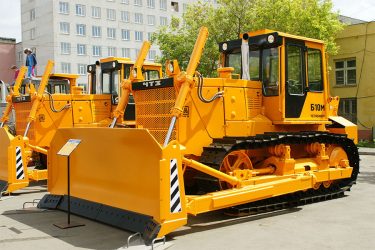
Chelyabinsk Tractor Plant develops and produces industrial tractors and motors for them. The manufacturer solves complex problems of designing, testing and putting new equipment into serial production. The Chelyabinsk Industrial Tractor Plant occupies a leading position in the Russian and CIS markets in the production of crawler tractors, bulldozers and pipe layers.
Model range of Chelyabinsk tractors
In 1933, the first Chelyabinsk equipment was produced. These are ChTZ Stalinets (S-60) tractors on caterpillar tracks, with a power of 60 hp. pp., which were fueled with naphtha fuel. The Stalitsets-2 (S-65) tractor had a power of 105 hp. With. The post-war Stalinets -80 was equipped with a closed cabin.
Models of tractors:
- T-100 (“weaving”) and T-100M (belong to class 10) with a power of 108 hp. With.;
- DET-250 (belongs to class 25). Diesel-electric models with a power of 310 hp. With.;
- T-800 is the largest ChTZ tractor with high performance (power 800 hp);
- Wheel-crawler mini-tractor "Uralets" with a power of 12 hp. With.
ChTZ tractors of the latest generation are constantly being modernized.
Along with serial products, since 2004 the plant began producing bulldozer-ripper machines:
- B12 with a power of 215 hp. s., weighing 24 tons, in traction class 15;
- DET-320 with a power of 350 hp. s., weighing 45 tons, in 25 traction class.
The Chelyabinsk Tractor Plant also produces power units and spare parts for its products.
Tractor ChTZ-100
The production of the car dates back to 1963. The tractor was used in the construction and road sectors. The powerful tracked unit is in traction class 6.
A tractor with a closed cab, which is heated and ventilated. Inside there is a comfortable driver's seat and unit control levers.
Specifications:
- Four-cylinder diesel engine with a power of 108 hp. With.;
- Engine displacement – 15.5 liters;
- PTO – 1070 rpm;
- Availability of an auxiliary engine running on P-23 gasoline with an electric starter;
- Availability of a cold engine start system;
- Fuel tank capacity – 235 liters;
- Three-way reversible gearbox;
- Maximum speed forward/backward – 10/7.5 km/h;
- Track width - 188 centimeters;
- Ground clearance - 33 centimeters;
- The weight of the unit is 11,000 kilograms.
The T-100 tractor was presented in several modifications. Each subsequent one has design modifications that expand the functionality of the units.
"Sotka" was produced in seven versions:
- T-100 MGS. A machine for agriculture with a full hitch with hydraulic mounting;
- T-100 MGP. We installed a rigid rear hitch and a front hydraulic linkage;
- T-100 B. With increased track width for swampy and difficult terrain;
- T-100 BG. A unit with greater functionality;
- T-100 T. Used as a pipe layer;
- T-100 MGP-1. The cab was removed, significantly reducing the weight of the tractor;
- T-100 MZGP. With improved turning mechanism. Servo drives were installed on the machine.
The advantages of the T-100 model are good power indicators, excellent maneuverability, reliability, and the ability to mount with 14 types of canopies.
External links
- Official website of "ChTZ-Uraltrak"
- "Iron stream. Battle of the Factories" is a 2020 documentary film directed by O. Vitvitsky on the Russia-Culture TV channel.
- ChTZ became part of the existing enterprises of the union. Magazine "Behind the Wheel" 11-12 1933
- At the border of Europe and Asia, the world's largest tractor, 13-1933, began work.
- “Sanctions deprived ChTZ of a life-saving investment project with Caterpillar”
| Tractor-building enterprises of the USSR | |
| |
Bulldozer ChTZ T 800
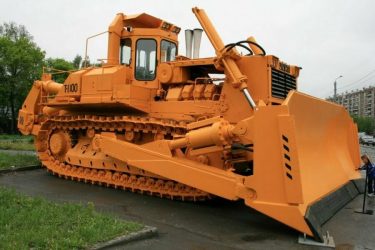
Manufactured by the Chelyabinsk Tractor Plant, the T-800 bulldozer performs the functions of a bulldozer and ripper. The machine has a caterpillar drive, a large mass, and its basis is a tractor. The second name of the car is T-75.01. The T-800 ChTZ is the largest and most productive European machine, thanks to which it was able to get into the Guinness Book of Records. The engine of the car is also worth special attention. The traction force of the equipment is 75 tons, so it belongs to the 75 traction class.
Bulldozer T 800
The production of the T-800 bulldozer began in 1983. The reason for its appearance was the need to complete large volumes of work in a short time. The main areas of application at that time were land reclamation, road construction and mining. However, the bulldozer is adapted to work in particularly difficult conditions - for example, for working with frozen and rocky soils.
Return to navigation
Hydraulic system
In the neutral position of the lever, the gear pumps included in the system are freed from any load. To ensure proper operation of the attachment, separate selectors are provided with which the operator controls the equipment. System type – separate-aggregate, two-stage.
Return to navigation
Price
The price of a new car is approximately 4.5-6.5 million rubles. A used bulldozer model will cost 2-3.5 million rubles.
You can rent for an hour for about 1200 rubles.
Return to navigation
